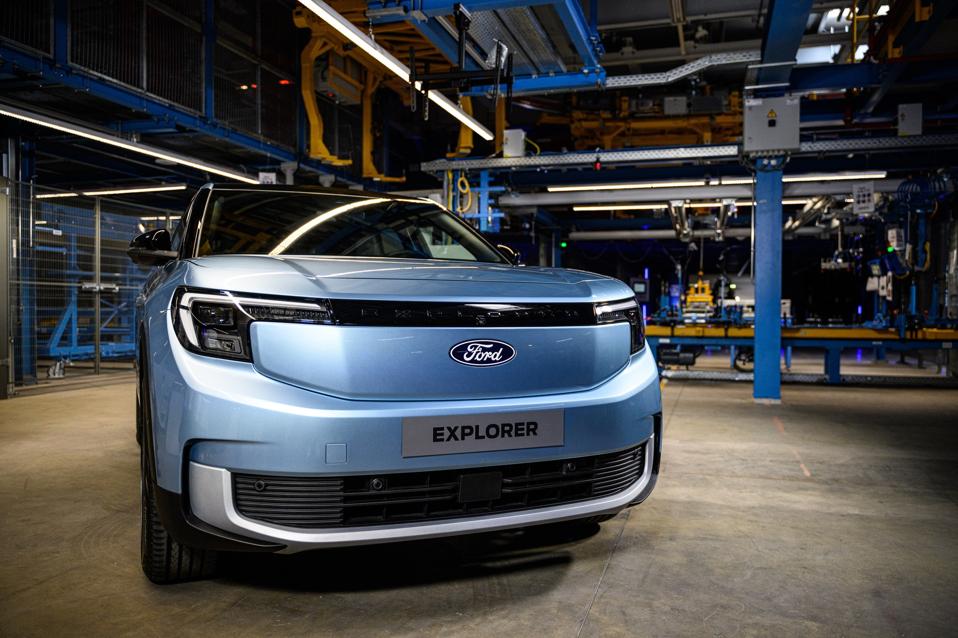Ford Europe’s market share has been sliding now for about 10 years as it rationalized its product portfolio by dropping smaller, less profitable models. It has boosted its electric vehicle offering and latest financial numbers point to a profit recovery, but not enough to stop talk that it may follow its compatriot General Motors out of Europe.
Profit margins have been declining too over a long period and a stumble over electric vehicle policy didn’t help. In 2021, Ford Europe was amongst the early manufacturers pledging to end the sale of new internal combustion engine-powered vehicles by 2030. This was dumped in 2024 when it became obvious public demand for EVs was unlikely to make this sensible.
This weak performance encouraged speculation that Ford might follow its compatriot General Motors out of Europe. GM sold its Opel/Vauxhall subsidiary to PSA Peugeot Citroen in 2017, which merged with Fiat Chrysler to become Stellantis in 2021.
According to Automotive News Europe, in the third quarter of 2025 Ford’s loss in Europe was $52 million before interest and taxes, compared with a loss of about $440 million in the same period last year.
Investment researcher Jefferies, in a recent report on the European automotive market, said Ford remains at risk of irrelevance.
“Ford’s low utilization in Europe driven by continuous share loss over several years raises doubts about Ford’s ability to retain a presence in the region, despite being a critical market for Pro’s (highly profitable) commercial vehicles,” Jefferies said.
Ford Europe has been asked to comment.
EV portfolio improving
Meanwhile, Ford Europe has improved its EV portfolio, and now has four contenders; the Mach-E, Explorer E, Capri EV and Puma Gen E. In September, Ford Europe’s EV sales rose 156% to 12,478 compared with the same month last year, according to Dataforce. The Explorer (see review) and Capri EVs are built in Europe using the basic engineering components supplied by Volkswagen from its ID.3 and ID.4. This deal was done to help Ford speed up its embrace of EVs.
Ford Europe needs new models to fill out its product portfolio. It needs to replace its Kuga SUV, and perhaps the little Fiesta, which went out of production last year. It’s not clear if new models will be electric-only. Probably not, given the momentum in Europe seems to be towards a dilution of the EV mandate which insists new cars in 2035 must only be electric.
Ford has embarked on a project in the U.S. for a new EV platform that could spawn up to eight models which would use cheaper LFP batteries, as opposed to the nickel manganese cobalt used for the European EVs now. It’s probably not a stretch to imagine one or two of those models might have Europe in mind.
West Europe market share halved in 10 years
Schmidt Automotive Research founder Matt Schmidt said Ford Europe is struggling and its Western Europe market share has halved over 10 years from 7.3% in 2015 to 3.6% in 2024, while stabilizing at 3.8% so far in 2025.
According to the European Automobile Manufacturers Association, in all of Europe, Ford’s market share was 3.3% in the first nine months of 2025, unchanged from 2024, with sales at 327,000. That’s less than premium manufacturers like Mercedes at 501,000 and BMW’s 595,000.
“Stripping one of your traditionally highest volume models out of the line-up doesn’t help, but if the Fiesta wasn’t turning a profit under ever stricter safety requirements for all cars, one can understand the decision of killing it (for now) and trying to push those customers into the higher margin Romanian-made Puma with consumers increasingly opting for a higher riding position anyway,” Schmidt said in an email exchange.
The industry and some governments are seeking changes in EU rules which may allow a bigger share for hybrids, plug-in hybrids, range-extenders and e-fuel combustion. The dream of only EVs from 2030 in Europe is over. Britain maintains its EV-only rule by 2030.
Karl Brauer, iSeeCars analyst, said upcoming likely changes in the European Union’s carbon dioxide emissions rules is complicating the playing field for EV makers in Europe. Producing cheaper EVs than the competition might work if that means going against other Europeans, but the incoming Chinese are a different proposition.
Ford’s EVs can compete against Europeans, but the Chinese?
“Ford’s product plan in Europe requires navigating that market’s ongoing shifts in EV regulations, making it difficult to predict the automaker’s long-term success. Producing electric vehicles at a substantially lower cost and higher rate of production benefits Ford, regardless of EV requirements in Europe, but it may not be enough to overcome China’s competitive advantages in these areas. It’s going to be a race between Ford’s speed-to-market and real-world cost reductions versus China’s existing cost advantages and established momentum in the European market,” Brauer said.
“The role of tariffs, and how those might shift in the near term, is another variable that’s hard to account for. Right now, it’s difficult to imagine any Western automaker outmaneuvering the Chinese in Europe,” he said.
Schmidt said Ford’s commercial vehicles business is thriving while sedans and SUVs stumble.
U.S. might run out of patience
“With the passenger car business looking like ending below 500,000 in Western Europe for the fourth time out of the last five years, one begins to question how much patience the U.S. parent still has. GM first started to become impatient with their Opel-venture while they were selling twice as many models across the same region as Ford is now,” according to Schmidt.
“Ford Europe also appears to be stuck in an identity crisis: is it an American company pushing that narrative, or a European company? Lack of confidence and uncertainty is never a good look,” Schmidt said.

